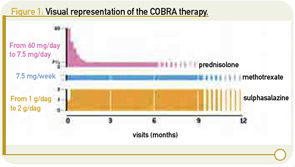From these focus groups, it appears that the rheumatologist is more afraid of COBRA therapy than the patient is and that the low prescription rate is mostly determined by the opinion of the rheumatologist.
11-Year Safety Data
Because rheumatologists expressed worries about the long-term side effects of the initial high dose of prednisolone, we performed a follow-up study to the COBRA trial.8 This study revealed that there were no real differences in long-term side effects between the two treatment groups (combination versus sulfasalazine) that could be contributed to the initial study drugs. Mortality in the COBRA group was numerically lower, and cardiovascular and other major comorbidities were similar to that in the sulfasalazine group. The prevalence of hypertension and diabetes was increased in the COBRA group but offset by a decrease in hypercholesterolemia. Prevalence of osteoporosis was also comparable. Moreover, at the discretion of the treating physician, if COBRA is continued for 10 years of therapy, the benefits on the disease itself and reduction in damage progression are maintained; these benefits may even continue to increase after COBRA therapy, depending on how one deals with the selective drop-out.8
Testing an Implementation Plan
After we evaluated all aspects of COBRA therapy from the patient’s and rheumatologist’s point of view, as well as the long-term effects on disease progression, we designed an implementation strategy.9 Our central objective was to make it easier and more agreeable for rheumatologists, patients, and arthritis nurses to use COBRA therapy in clinical practice. Many clues for improvement of daily use by rheumatologists as well as patients were extracted from the rich data gathered during focus group discussions.
As we learned in our survey and focus group, rheumatologists felt that COBRA therapy is complicated and takes a lot of time to prescribe. Furthermore, they felt that patients might object to the use of a large number of pills, including prednisolone. To remove the barrier of workload and provision of tailored information, we developed a patient information booklet, including visual aids to explain the therapy, clear tables on the intake of the different drugs, and preprinted prescriptions to speed up the prescribing process. (See Figure 2, at right.) We also disseminated the results of the patient focus groups, in which patients explained that the temporary use of a large amount of pills or prednisolone was acceptable, as long as this would take away their immediate complaints and improve their prognosis.
